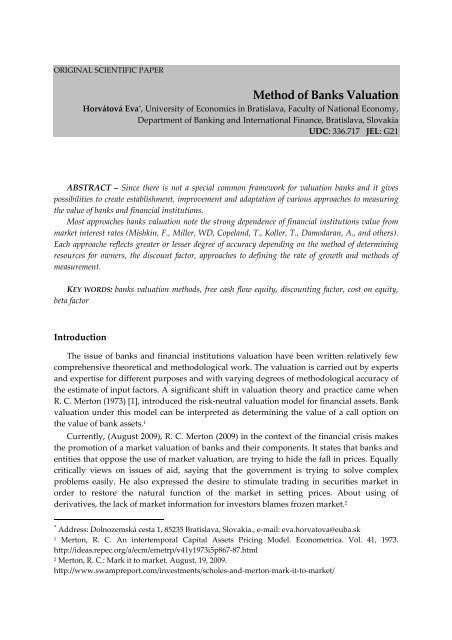Twice a Year Scientific Journal
Twice a Year Scientific Journal
Twice a Year Scientific Journal
Create successful ePaper yourself
Turn your PDF publications into a flip-book with our unique Google optimized e-Paper software.
ORIGINAL SCIENTIFIC PAPER<br />
Method of Banks Valuation<br />
Horvátová Eva * , University of Economics in Bratislava, Faculty of National Economy,<br />
Department of Banking and International Finance, Bratislava, Slovakia<br />
UDC: 336.717 JEL: G21<br />
ABSTRACT – Since there is not a special common framework for valuation banks and it gives<br />
possibilities to create establishment, improvement and adaptation of various approaches to measuring<br />
the value of banks and financial institutions.<br />
Most approaches banks valuation note the strong dependence of financial institutions value from<br />
market interest rates (Mishkin, F., Miller, WD, Copeland, T., Koller, T., Damodaran, A., and others).<br />
Each approache reflects greater or lesser degree of accuracy depending on the method of determining<br />
resources for owners, the discount factor, approaches to defining the rate of growth and methods of<br />
measurement.<br />
KEY WORDS: banks valuation methods, free cash flow equity, discounting factor, cost on equity,<br />
beta factor<br />
Introduction<br />
The issue of banks and financial institutions valuation have been written relatively few<br />
comprehensive theoretical and methodological work. The valuation is carried out by experts<br />
and expertise for different purposes and with varying degrees of methodological accuracy of<br />
the estimate of input factors. A significant shift in valuation theory and practice came when<br />
R. C. Merton (1973) [1], introduced the risk-neutral valuation model for financial assets. Bank<br />
valuation under this model can be interpreted as determining the value of a call option on<br />
the value of bank assets. 1<br />
Currently, (August 2009), R. C. Merton (2009) in the context of the financial crisis makes<br />
the promotion of a market valuation of banks and their components. It states that banks and<br />
entities that oppose the use of market valuation, are trying to hide the fall in prices. Equally<br />
critically views on issues of aid, saying that the government is trying to solve complex<br />
problems easily. He also expressed the desire to stimulate trading in securities market in<br />
order to restore the natural function of the market in setting prices. About using of<br />
derivatives, the lack of market information for investors blames frozen market. 2<br />
* Address: Dolnozemská cesta 1, 85235 Bratislava, Slovakia., e-mail: eva.horvatova@euba.sk<br />
1<br />
Merton, R. C. An intertemporal Capital Assets Pricing Model. Econometrica. Vol. 41, 1973.<br />
http://ideas.repec.org/a/ecm/emetrp/v41y1973i5p867-87.html<br />
2<br />
Merton, R. C.: Mark it to market. August, 19, 2009.<br />
http://www.swampreport.com/investments/scholes-and-merton-mark-it-to-market/
















